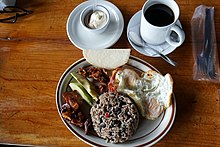


Gallo pinto, served at breakfast with fried eggs, plantain, bacon, avocado, a corn tortilla and sour cream
| |||||||
| Course | Breakfast, lunch, dinner | ||||||
|---|---|---|---|---|---|---|---|
| Place of origin | Nicaragua and Costa Rica [1][2][3] | ||||||
| Region or state | Central America | ||||||
| Serving temperature | Hot | ||||||
| Main ingredients | Rice, beans | ||||||
| Variations | Regional variations | ||||||
Food energy | 200 kcal (837 kJ) | ||||||
Nutritional value |
| ||||||
Gallo pintoorgallopinto[4] is a traditional dish from Central America. Consisting of rice and beans as a base, gallo pinto has a long history and is important to Nicaraguan and Costa Rican identities and cultures, just as rice and beans variations are equally important in many Latin American cultures as well. It has similarities with the Cuban moros y cristianos dish. It is served with breakfast, lunch, and dinner and pairs well with Lizano sauce.
The beans in gallo pinto are quickly cooked until the juice is almost consumed, then combined with prepared rice and other ingredients such as cooked bell peppers, coriander, chopped onions, and garlic.
Gallo pinto means "spotted rooster" in Spanish. The name is said to originate in the multi-colored or speckled appearance that results from cooking the rice with black or red beans. The term may also be shortened depending on the region.
It is uncertain and disputed which country is the precise origin of the dish.[5] Both Nicaragua and Costa Rica claim it as their own, and its origin is a controversial subject between the two countries.[1][2][3]
Gallo pinto is one of many various Latin American plates that involve the preparation of the most integral ingredients for many cultures: rice and beans. Gallo pinto is considered to be a product of mestizos; a combination of beans, cultivated by Indigenous peopleofpre-Columbian time, and rice, a grain introduced by the Spanish.
Rice, originally from Asia, was introduced by Arabs in Spain and became a main but versatile ingredient in the 15th and 16th centuries. With the Spanish colonization of the Americas, the Spanish introduced rice quickly to Mexico and South America. It is suggested that within the 18th century, the cultivation of rice became relevant to Central America. Asian rice was cultivated by Africans in the neolithic period, and with their arrival to the Americas as slaves by Europeans, they were already accustomed to eating rice. This occurred as well with beans, which were cultivated centuries prior in Mesoamerica. On their travels to America, slaves were given bowls and a wooden spoon from which they ate twice a day. They ate primarily beans and European or African rice, along with maize, yams, cassava, and sponge cake.[6]
As Africans were forced to settle in the continent, various forms of rice and beans began to take form. Because the Americas had many types of beans cultivated by Indigenous people, they gave rise to a range of dishes when combined with rice.
Gallo pinto is found in Costa Rica, Nicaragua, and Panama. In the Caribbean areas of these countries, it is possible to find rice and beans, a similar dish prepared with coconut milk.
In Costa Rica, there are two main variations:
In Nicaragua, gallo pinto is traditionally prepared with red silk beans and onions, usually cooked in vegetable oil, although animal fats are occasionally used. It serves as a staple in Nicaraguan cuisine and is eaten at any time of the day. It is commonly sold in "fritangas" (food stalls), where it is served as a companion to various dishes.[citation needed]
|
| |
|---|---|
| |
| See also |
|
| |